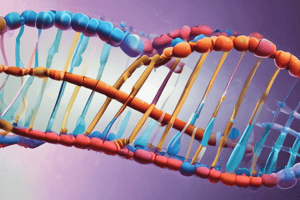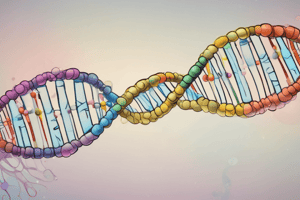Podcast
Questions and Answers
What is the role of DNA polymerase I in lagging strand synthesis?
What is the role of DNA polymerase I in lagging strand synthesis?
- To join the Okazaki fragments together
- To remove the RNA primers and replace them with DNA (correct)
- To synthesize the new DNA strand continuously
- To synthesize the RNA primer
What are the short segments of DNA synthesized during lagging strand synthesis called?
What are the short segments of DNA synthesized during lagging strand synthesis called?
- Leading strands
- DNA ligase fragments
- Okazaki fragments (correct)
- Primase fragments
What is the role of DNA ligase in DNA replication?
What is the role of DNA ligase in DNA replication?
- To stabilize the unwound ssDNA
- To synthesize the new DNA strand
- To join the Okazaki fragments together (correct)
- To remove the RNA primers
During leading strand synthesis, DNA polymerase synthesizes the new DNA strand in which direction?
During leading strand synthesis, DNA polymerase synthesizes the new DNA strand in which direction?
What is the purpose of the RNA primer during lagging strand synthesis?
What is the purpose of the RNA primer during lagging strand synthesis?
What happens to the RNA primer after the synthesis of an Okazaki fragment?
What happens to the RNA primer after the synthesis of an Okazaki fragment?
What is the role of primase during lagging strand synthesis?
What is the role of primase during lagging strand synthesis?
What is the result of the combination of leading strand synthesis and lagging strand synthesis?
What is the result of the combination of leading strand synthesis and lagging strand synthesis?
What is the main obstacle in DNA polymerase during leading strand synthesis?
What is the main obstacle in DNA polymerase during leading strand synthesis?
What is the role of RNA polymerase in DNA synthesis?
What is the role of RNA polymerase in DNA synthesis?
What is the characteristic of Okazaki fragments?
What is the characteristic of Okazaki fragments?
Why is DNA ligase not necessary during leading strand synthesis?
Why is DNA ligase not necessary during leading strand synthesis?
What is the consequence of DNA polymerase incorporating a non-complementary nucleotide during synthesis?
What is the consequence of DNA polymerase incorporating a non-complementary nucleotide during synthesis?
What is the significance of the RNA primer during DNA synthesis?
What is the significance of the RNA primer during DNA synthesis?
Why is DNA polymerase necessary for lagging strand synthesis?
Why is DNA polymerase necessary for lagging strand synthesis?
What is the purpose of DNA primase in DNA synthesis?
What is the purpose of DNA primase in DNA synthesis?
What is the direction of DNA synthesis by DNA Polymerase?
What is the direction of DNA synthesis by DNA Polymerase?
What is unique about the DNA synthesis in eukaryotic cells compared to bacterial cells?
What is unique about the DNA synthesis in eukaryotic cells compared to bacterial cells?
What is the function of the 3' -OH group in DNA synthesis?
What is the function of the 3' -OH group in DNA synthesis?
What is the result of the breakage of the phosphoanhydride bond in DNA synthesis?
What is the result of the breakage of the phosphoanhydride bond in DNA synthesis?
What is the orientation of the strands in a double-stranded DNA molecule?
What is the orientation of the strands in a double-stranded DNA molecule?
What is necessary for DNA synthesis to occur?
What is necessary for DNA synthesis to occur?
What is the result of the mechanism of catalysis during DNA synthesis?
What is the result of the mechanism of catalysis during DNA synthesis?
What is the substrate for DNA synthesis?
What is the substrate for DNA synthesis?
Flashcards are hidden until you start studying
Study Notes
DNA Replication
- DNA replication occurs in the 5' to 3' direction.
- It begins at one origin (Ori) site in bacteria and at multiple sites in eukaryotic cells.
Lagging Strand Synthesis
- Synthesized discontinuously in short segments called Okazaki fragments, each initiated by an RNA primer.
- RNA primer is later elongated by DNA polymerase.
- DNA polymerase disengages and re-engages at a new primer upon reaching the next RNA primer.
- The DNA template loops to ensure both polymerases move in the same direction.
Leading Strand Synthesis
- Synthesized continuously in the 5' to 3' direction by DNA polymerase.
Fragment Maturation
- RNA primers are removed by DNA polymerase I.
- Gaps are filled with DNA by DNA polymerase I.
- Okazaki fragments are joined by DNA ligase to form a continuous DNA strand.
DNA Polymerase
- Synthesizes DNA in the 5' to 3' direction.
- Has proofreading ability.
- Requires a 3' OH group to add onto.
- Reads the template DNA in the 3' to 5' direction.
Mechanism of Catalysis
- The 3' OH of the last nucleotide attacks the phosphate of the incoming nucleotide (triphosphate).
- Substrates are deoxynucleoside triphosphates.
- Breaks the phosphoanhydride bond in the nucleotide and forms a phosphodiester bond.
Overcoming Obstacles in DNA Polymerase
- DNA polymerase can only extend an existing chain and needs a 3' OH group to build on.
- Solution: Use RNA polymerase (DNA primase) to make a short RNA primer, which provides a 3' OH group for DNA polymerase to build on.
Studying That Suits You
Use AI to generate personalized quizzes and flashcards to suit your learning preferences.




